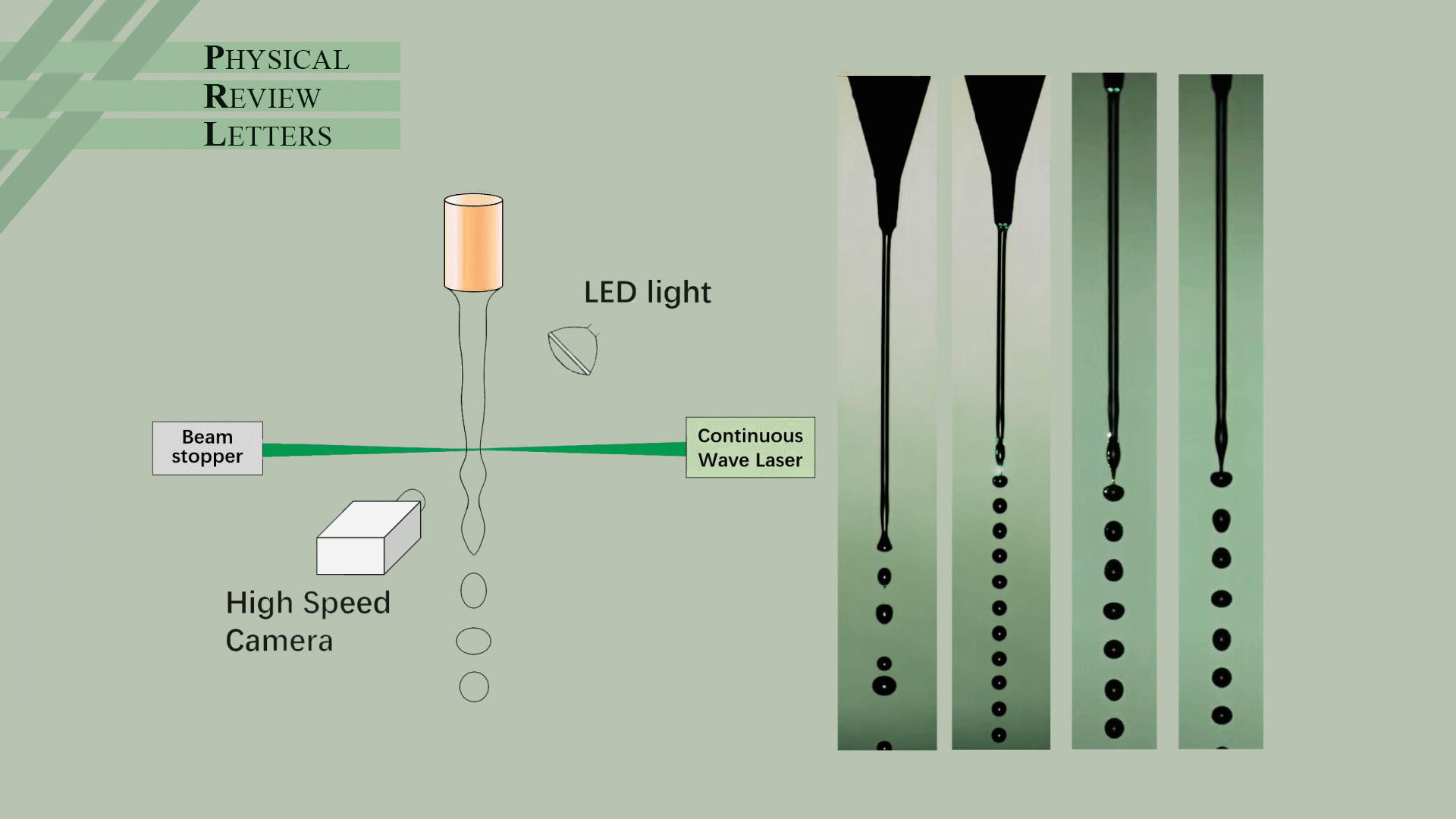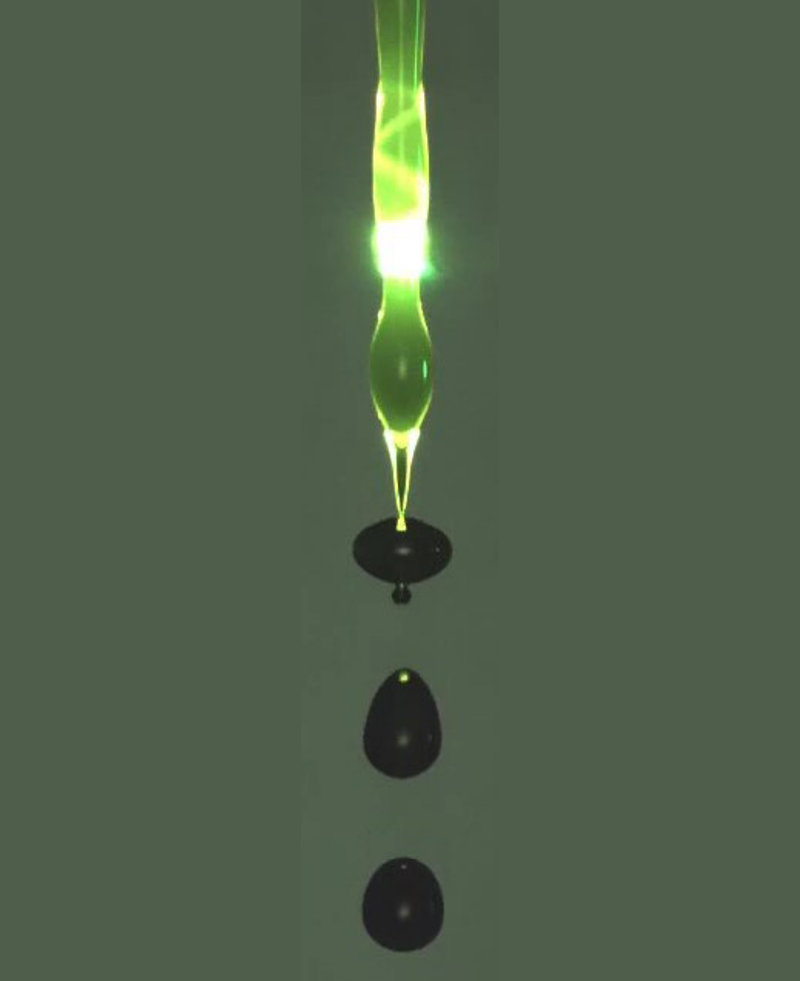In continuous inkjet technology, a liquid jet under the influence of an electric field breaks into a sequence of droplets. Researchers have now shown that such a jet can be controlled with a laser beam, producing highly uniform droplets. The technique could lead to improved control over droplet breakup, and it demonstrates new possibilities for using optical forces to manipulate liquid-air interfaces.
Professor Weiwei Deng and his colleagues at the Southern University of Science and Technology (SUSTech) have long been interested in light-matter interactions, inspired by physics Nobel Laureate Arthur Ashkin, inventor of a technique for moving particles with light known as optical tweezers. Their research, entitled “Optofluidic Resonance of a Transparent Liquid Jet Excited by a Continuous Wave Laser,” was recently published as the cover article in the Physical Review Letters (PRL).

The team’s experiment involved pumping a jet of ethanol downward through a nozzle that could vary the jet’s diameter from 120 to 500 micrometers. They focused a green or red laser beam onto the jet at a location between the nozzle and the point where the jet broke up into droplets.
By varying the laser beam’s position and brightness, the researchers found that they could cause the jet to transition from a random breakup to an ordered breakup in which the droplets had nearly uniform diameter and spacing. In the ordered mode, the jet region immediately below the nozzle was alternately illuminated and dark, indicating that the laser beam was periodically transmitted upstream through the jet at the same frequency with which droplets were breaking off.

Figure 1. A laser beam causes a column of liquid to break into multiple uniform droplets
Like water from a tap, a narrow liquid jet emerging downward from a nozzle is inherently unstable. Surface tension amplifies random surface waves that begin at the top and cause the jet to break into droplets at the bottom. Ordinarily, the droplets have a range of sizes and shapes and are randomly spaced. However, a steady and uniform sequence of droplets can be produced by exciting the jet with an external periodic driving force, typically mechanical, acoustical, or electrical (Video 1). If the driving frequency matches the jet’s intrinsic vibration frequency, large ripples develop along the surface, leading to uniform droplets.
Prof Deng’s team saw the same behavior in numerical simulations of the experiment. They learned that the surface waves at the point where the laser hits the jet serve as an oscillating mirror that periodically reflects the laser beam upstream, and the liquid jet acts as an optical fiber. They also found that the main effect of the laser comes at the top of the jet, where the light concentrates in the meniscus region. The tiny perturbations of the surface produced by the light in this region are amplified lower down the jet and lead to the uniform droplet pinch-off. With the right light intensity and positioning, the liquid automatically “locks in” to the natural frequency that produces the uniform droplets.
Video 1. Droplets form at the bottom of the liquid stream with a range of sizes and spacings (left). Still, with the laser hitting the stream slightly above the normal breakup location (center of right-hand video), the droplets become uniformly sized. Note the flashing green illumination in the meniscus region at the top, just below the nozzle. Laser light is reflected up the jet by the periodic pinching off of droplets, a key part of the process.
This new effect could be used to activate droplet production from a distance using laser beams. Highly uniform droplets may be used in inkjet printing and in producing droplet size standards for calibrating aerosol instruments. But, says Deng, “we don’t know exactly how to do that yet. It is the beauty of the physics that ultimately motivates us.”
This paper was featured as the cover article of Volume 127, Issue 24 of the PRL. It was also selected as the Editors’ Suggestion. According to APS (American Physics of Society, the publisher of PRL), only about “one Letter in seven is highlighted as a Suggestion due to its particular importance, innovation, and broad appeal.”
Haoyu Liu from the Department of Mechanics and Aerospace Engineering (MAE) at SUSTech is the first author of this paper. Prof. Weiwei Deng from MAE and Prof. Xinyan Zhao from the SUSTech Academy for Advanced Interdisciplinary Studies are the corresponding authors. Zhibei Wang and Lihao Gao, Ph.D. students at SUSTech, Prof. Yongan Huang from Huazhong University of Science and Technology (HUST), and Prof. Hui Tang from the Hong Kong Polytechnic University (PolyU), are the co-authors.
This research was supported by the National Natural Science Foundation of China (NSFC), Guangdong Provincial Innovation and Entrepreneurship Project, and Guangdong Provincial Key Laboratory Program.
Related links:
Paper link (Physical Review Letters): https://journals.aps.org/prl/abstract/10.1103/PhysRevLett.127.244502
APS Physics: https://physics.aps.org/articles/v14/174
To read all stories about SUSTech science, subscribe to the monthly SUSTech Newsletter.
Proofread ByAdrian Cremin, Yingying XIA
Photo By